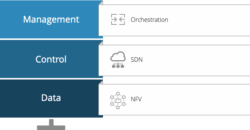There has been tremendous innovation in IT infrastructure with the adoption of cloud-scale architecture and a migration towards modern applications. In contrast, Enterprise networking has been viewed over the last 30 years primarily for moving data between client-server applications. This basic premise along with consumer devices drove innovation in the network domain to prioritize “speeds and feeds” as the primary objective for networking vendors. Even with the adoption of cloud-scale infrastructure, most adoption meant a migration from current data centers to cloud platforms for IaaS (Infrastructure as a Service) which didn’t dramatically impact networking requirements.
For some context on network innovation, it is important to break network devices into their logical components. A simplified view of networks separates general functionality into three primary components:

- Data Plane — Movement of packets or network data between network elements
- Control Plane — Decision logic of where to send network data on the data plane
- Management Plane — Interfaces that allow users and external systems to modify the behavior of the network.
Although innovation and R&D has been amazing at supporting high-speed networks, a predominant focus has been historically focused on the data plane. With the adoption of virtualized infrastructure that support Software-Defined Data Centers (SDDC) and Software-Defined WAN (SD-WAN), innovation focused on the Control Plane has increased dramatically. The focus of software-defined networking represents the centralization of the control plane into a software system called an SDN Controller. Rather than a distributed set of elements passing control plane information to determine routing information, the SDN Controller performs these decisions and distributes control plane results to the equipment to focus on data plane and drive more efficient networks. These controllers accelerate the move towards software-centric networking with robust APIs for a new programmable paradigm.
Network innovation continues to migrate away from large, physical networks towards more flexible, virtualized infrastructure. This has many parallels to other IT infrastructure such as compute and storage. We don’t have to envision the future for networking as much as look to our peers in other IT infrastructure and application development domains to understand both our challenges and most likely solutions.
Moving Past the CLI
The Management plane for network equipment continues to be dominated by the command line interface (CLI). While a great innovation for its time, its dominance and success has been a deterrent to new innovation. One reason the CLI has been so successful is that network equipment and protocols are complex. The CLI provides an abstraction which doesn’t require a user to understand the intricacies of the network software implementation. Removing the CLI will require similar abstractions to exist for machine interfaces that can model the behavior of network equipment to provide tooling and development paradigms to allow for machine-centric innovation.
NETCONF/YANG
While the CLI was meant for human operators, the most common legacy machine interface has been SNMP (Simple Network Management Protocol). While SNMP was successful for assurance activities such as fault & performance management, it has been a failure for network configuration and change activities. SNMPs failure led to the innovation of NETCONF/YANG. Network equipment is being shipped with NETCONF interfaces at an accelerated rate due to the demand from Network Operations teams to only buy equipment supporting modern programmable interfaces. While YANG has made significant progress with IP networks, we are seeing innovation begin to take hold in other forms.
Evolution to REST/JSON Schema
We are now seeing REST interfaces directly embedded on Network Equipment with a focus on virtualized applications. As network equipment is decomposed into individual, containerized applications, REST interfaces become more applicable due to the limited configuration which is required.
The largest impact on the management plane is the introduction of controllers and orchestration platforms that are centralizing the OAM (Operations, Administration, and Management). The migration to a software-first model is the largest impact on the management plane. The introduction of software platforms with control of the network is the primary innovation which is transforming how we build and operate networks.
With integration and JSON data structures dominating the integration landscape, networking applications strive to support model-centric capabilities. It is critical that we apply modeling techniques and specifically JSON Schema to support dynamic, real-time network management applications. Similar to YANG for network-facing device models, JSON Schema allows for similar modeling logic for integration with Controllers, Orchestrators, and IT Systems.
Why is this so important?
The lack of investment in the management plane combined with the complexity of modern networks has created a situation where management applications are constraining the ability to consume complex, modern networks. This deserves tremendous R&D and investment, or it could be an impediment to the rollout and adoption of software-centric networks related to IoT, 5G, and cloud edge networking which assumes and requires automation.
Whether led by standards bodies, open source communities, vendors, or user groups, it is critical that we garner the focus and attention required. Operationalizing these technologies are paramount for the next wave of innovation and an ecosystem is building to support these machine first autonomous networks.
Originally published on The New Stack.



![[Research] The Current State of Network Automation Initiatives, Goals, Use Cases & Source of Truth](https://www.itential.com/wp-content/uploads/2020/02/Blog-Feature-CurrentStateofNA-400x200.png)

